The Energy-Economy Nexus of Advanced Air Pollution Control Technologies: Pathways to Sustainable Development
Abstract
1. Introduction
1.1. The Economic Burden of Air Pollution
1.2. Quantifying the Costs of Inaction vs. Proactive Pollution Control
1.3. The Need for Advanced Pollution Control Technologies
1.4. The Intersection of Environmental Sustainability and Economic Growth
1.5. Purpose and Scope of This Review
2. Methodology
2.1. Search Strategy
2.2. Inclusion and Exclusion Criteria
2.3. Data Extraction and Synthesis
3. Understanding the Economics of Air Pollution Control
3.1. Core Economic Principles
3.2. Measuring the Economic Impact of Air Pollution
4. Advanced Pollution Control Technologies: Economic Perspectives
4.1. Overview of State-of-the-Art Solutions
4.2. Renewable Energy-Powered Pollution Control
4.3. Cost-Benefit Analysis of Advanced Technologies
4.4. Case Studies from Low- and Middle-Income Countries
4.4.1. Biomass-to-Energy Air Scrubbers in Rural India
4.4.2. Solar-Powered Nanofilter Projects in Kenya
4.4.3. Air Quality Sensor Grids in Peru’s Mining Regions
4.5. Potential Drawbacks and Challenges
4.5.1. Technology Lock-In Risks with CCS
4.5.2. High R&D Overhead for Nanomaterials
4.5.3. End-of-Life Challenges with AI Sensor Systems
4.6. Life-Cycle Cost Assessment
5. Economic Externalities and Societal Benefits
5.1. Public Health Savings
5.2. Environmental and Ecosystem Benefits
5.3. Productivity and Economic Growth
6. Market Dynamics and Economic Incentives
6.1. The Economics of Pollution Control Markets
6.2. Government Policies and Economic Instruments
- (i)
- Tax credits for R&D in pollution control technologies enable companies to develop cost-effective solutions [133].
- (ii)
- Public-private partnerships (PPPs) that co-finance green technology adoption help businesses offset initial capital costs [134].
- (iii)
- Green procurement policies, where governments prioritize environmentally friendly suppliers for public contracts, create market demand for clean air technologies [135].
6.3. Industry Stakeholders Engagement
6.3.1. IEA Clean Air Technology Barometer
6.3.2. McKinsey & Company’s Industrial Decarbonization Survey
6.3.3. World Economic Forum Reports on ESG-Aligned Technology Adoption
6.4. International Economic Cooperation
7. Economic Barriers and Strategies for Widespread Adoption
7.1. High Upfront Costs and Return on Investment Concerns
7.2. Market Failures and Policy Gaps
7.3. Addressing Regional Economic Disparities
7.4. Political Feasibility and Industry Influence on CCS Adoption
8. Future Economic Outlook and Emerging Opportunities
8.1. Projected Economic Benefits of Widespread Adoption
8.2. Climate Change Mitigation and Economic Resilience
9. Conclusions
Supplementary Materials
Author Contributions
Funding
Data Availability Statement
Conflicts of Interest
Abbreviations
| Abbreviation | Definition |
| BCA | Border Carbon Adjustment |
| CAPEX | Capital Expenditure |
| CCS | Carbon Capture and Storage |
| CH4 | Methane |
| CO2 | Carbon Dioxide |
| COI | Cost of Illness |
| EoL | End of Life |
| EOR | Enhanced Oil Recovery |
| GDP | Gross Domestic Product |
| LCA | Life-Cycle Assessment |
| LEZ | Low Emission Zone |
| MOF | Metal-Organic Framework |
| NDC | Nationally Determined Contributions |
| NOx | Nitrogen Oxides |
| OECD | Organization for Economic Co-operation and Development |
| OPEX | Operational Expenditure |
| PM2.5 | Particulate Matter 2.5 |
| PPP | Public-Private Partnership |
| R&D | Research and Development |
| ROI | Return on Investment |
| SME | Small and Medium-Sized Enterprise |
| SO2 | Sulfur Dioxide |
| UNEP | United Nations Environment Program |
| VOC | Volatile Organic Compounds |
| WHO | World Health Organization |
| WTO | World Trade Organization |
| WTP | Willingness to Pay |
References
- Isaifan, R.J.; Al-Thani, H.G. Action Taken to Reduce Air Pollution and Its One Health Impacts in MENA Countries. In Sustainable Strategies for Air Pollution Mitigation: Development, Economics, and Technologies; Ogwu, M.C., Izah, S.C., Eds.; Springer Nature: Cham, Switzerland, 2024; pp. 439–473. ISBN 978-3-031-74157-9. [Google Scholar]
- Atash, F. The Deterioration of Urban Environments in Developing Countries: Mitigating the Air Pollution Crisis in Tehran, Iran. Cities 2007, 24, 399–409. [Google Scholar] [CrossRef]
- Kumar, P.; Imam, B. Footprints of Air Pollution and Changing Environment on the Sustainability of Built Infrastructure. Sci. Total Environ. 2013, 444, 85–101. [Google Scholar] [CrossRef] [PubMed]
- He, J.; Liu, H.; Salvo, A. Severe Air Pollution and Labor Productivity: Evidence from Industrial Towns in China. Am. Econ. J. Appl. Econ. 2019, 11, 173–201. [Google Scholar] [CrossRef]
- Isaifan, R.J. Air Pollution Burden of Disease over Highly Populated States in the Middle East. Front. Public Health 2023, 10, 1002707. [Google Scholar] [CrossRef]
- Rao, C.; Yan, B. Study on the Interactive Influence between Economic Growth and Environmental Pollution. Environ. Sci. Pollut. Res. 2020, 27, 39442–39465. [Google Scholar] [CrossRef]
- Awe, Y.A.; Larsen, B.K.; Sanchez-Triana, E. The Global Health Cost of PM 2.5 Air Pollution: A Case for Action Beyond 2021; World Bank Group: Washington, DC, USA, 2022. [Google Scholar]
- Boldo, E.; Medina, S.; Le Tertre, A.; Hurley, F.; Mücke, H.-G.; Ballester, F.; Aguilera, I.; Eilstein, D.; on Behalf of the Apheis Group. Apheis: Health Impact Assessment of Long-Term Exposure to PM2.5 in 23 European Cities. Eur. J. Epidemiol. 2006, 21, 449–458. [Google Scholar] [CrossRef]
- Chossière, G.P.; Malina, R.; Ashok, A.; Dedoussi, I.C.; Eastham, S.D.; Speth, R.L.; Barrett, S.R.H. Public Health Impacts of Excess NOx Emissions from Volkswagen Diesel Passenger Vehicles in Germany. Environ. Res. Lett. 2017, 12, 034014. [Google Scholar] [CrossRef]
- Orellano, P.; Reynoso, J.; Quaranta, N. Short-Term Exposure to Sulphur Dioxide (SO2) and All-Cause and Respiratory Mortality: A Systematic Review and Meta-Analysis. Environ. Int. 2021, 150, 106434. [Google Scholar] [CrossRef]
- Yang, P.; Zhang, Y.; Wang, K.; Doraiswamy, P.; Cho, S.-H. Health Impacts and Cost-Benefit Analyses of Surface O3 and PM2.5 over the U.S. under Future Climate and Emission Scenarios. Environ. Res. 2019, 178, 108687. [Google Scholar] [CrossRef]
- World Health Organization Air Pollution. Compendium of WHO and Other UN Guidance on Health And Environment; World Health Organization: Geneva, Switzerland, 2024. [Google Scholar]
- He, Q.; Ji, X. The Labor Productivity Consequences of Exposure to Particulate Matters: Evidence from a Chinese National Panel Survey. Int. J. Environ. Res. Public Health 2021, 18, 12859. [Google Scholar] [CrossRef]
- Lee, Y. Workplace Health and Its Impact on Human Capital: Seven Key Performance Indicators of Workplace Health. In Indoor Environment and Health; IntechOpen: London, UK, 2019; ISBN 978-1-78984-374-3. [Google Scholar]
- Chen, S.; Oliva, P.; Zhang, P. The Effect of Air Pollution on Migration: Evidence from China. J. Dev. Econ. 2022, 156, 102833. [Google Scholar] [CrossRef]
- Pandey, A.; Brauer, M.; Cropper, M.L.; Balakrishnan, K.; Mathur, P.; Dey, S.; Turkgulu, B.; Kumar, G.A.; Khare, M.; Beig, G.; et al. Health and Economic Impact of Air Pollution in the States of India: The Global Burden of Disease Study 2019. Lancet Planet. Health 2021, 5, e25–e38. [Google Scholar] [CrossRef] [PubMed]
- Holian, M.J. The Effect of Social and Economic Development on Air Pollution in Indian Cities. Environ. Urban. Asia 2014, 5, 1–15. [Google Scholar] [CrossRef]
- Burney, J.; Ramanathan, V. Recent Climate and Air Pollution Impacts on Indian Agriculture. Proc. Natl. Acad. Sci. USA 2014, 111, 16319–16324. [Google Scholar] [CrossRef]
- Nowroz, F.; Hasanuzzaman, M.; Siddika, A.; Parvin, K.; Caparros, P.G.; Nahar, K.; Prasad, P.V.V. Elevated Tropospheric Ozone and Crop Production: Potential Negative Effects and Plant Defense Mechanisms. Front. Plant Sci. 2024, 14, 1244515. [Google Scholar] [CrossRef]
- McGrath, J.M.; Betzelberger, A.M.; Wang, S.; Shook, E.; Zhu, X.-G.; Long, S.P.; Ainsworth, E.A. An Analysis of Ozone Damage to Historical Maize and Soybean Yields in the United States. Proc. Natl. Acad. Sci. USA 2015, 112, 14390–14395. [Google Scholar] [CrossRef]
- Reynolds, T.W.; Waddington, S.R.; Anderson, C.L.; Chew, A.; True, Z.; Cullen, A. Environmental Impacts and Constraints Associated with the Production of Major Food Crops in Sub-Saharan Africa and South Asia. Food Sec. 2015, 7, 795–822. [Google Scholar] [CrossRef]
- OECD. The Economic Consequences of Outdoor Air Pollution; OECD: Paris, France, 2016; pp. 1–120. [Google Scholar]
- Clean Air Fund. The State of Global Air Quality Funding; Clean Air Fund: London, UK, 2023. [Google Scholar]
- Xie, Y.; Zhong, H.; Weng, Z.; Guo, X.; Kim, S.E.; Wu, S. PM2.5 Concentration Declining Saves Health Expenditure in China. Front. Environ. Sci. Eng. 2023, 17, 90. [Google Scholar] [CrossRef]
- Kwiatkowski, S.; Polat, M.; Yu, W.; Johnson, M.S. Industrial Emissions Control Technologies: Introduction. In Air Pollution Sources, Statistics and Health Effects; Goodsite, M.E., Johnson, M.S., Hertel, O., Eds.; Springer US: New York, NY, USA, 2021; pp. 477–511. ISBN 978-1-0716-0596-7. [Google Scholar]
- Ganesan, K.; Theodore, L. Air Pollution Control Engineering. In Handbook of Environmental Engineering; John Wiley & Sons, Ltd.: Hoboken, NJ, USA, 2018; pp. 453–492. ISBN 978-1-119-30441-8. [Google Scholar]
- Aithal, S.; Aithal, P.S. Nanotechnology Based Mega Machine Design for Large Scale Air Cleaning—Prospects and Challenges. Int. J. Case Stud. Bus. IT Educ. (IJCSBE) 2020, 4, 250–269. [Google Scholar] [CrossRef]
- Zanoletti, A.; Bilo, F.; Federici, S.; Borgese, L.; Depero, L.E.; Ponti, J.; Valsesia, A.; La Spina, R.; Segata, M.; Montini, T.; et al. The First Material Made for Air Pollution Control Able to Sequestrate Fine and Ultrafine Air Particulate Matter. Sustain. Cities Soc. 2020, 53, 101961. [Google Scholar] [CrossRef]
- Napp, T.A.; Gambhir, A.; Hills, T.P.; Florin, N.; Fennell, P.S. A Review of the Technologies, Economics and Policy Instruments for Decarbonising Energy-Intensive Manufacturing Industries. Renew. Sustain. Energy Rev. 2014, 30, 616–640. [Google Scholar] [CrossRef]
- Mujtaba, G.; Shahzad, S.J.H. Air Pollutants, Economic Growth and Public Health: Implications for Sustainable Development in OECD Countries. Environ. Sci. Pollut. Res. 2021, 28, 12686–12698. [Google Scholar] [CrossRef] [PubMed]
- Zhou, X.; Zhao, Y. Breathe Easier, Work Better: The Golden Rule of Air Quality, Employee Adhesion, and Employee Efficiency. 2025. Available online: https://ssrn.com/abstract=5188524 (accessed on 28 March 2025).
- Jenkins, R.; Barton, J.; Bartzokas, A.; Hesselberg, J.; Knutsen, H.M. Environmental Regulation in the New Global Economy; Edward Elgar Publishing: Gloucestershire, UK, 2002; ISBN 978-1-78195-041-8. [Google Scholar]
- van den Bergh, J.C.J.M. Externality or Sustainability Economics? Ecol. Econ. 2010, 69, 2047–2052. [Google Scholar] [CrossRef]
- Randall, A. Market Solutions to Externality Problems: Theory and Practice. Am. J. Agric. Econ. 1972, 54, 175–183. [Google Scholar] [CrossRef]
- Sovacool, B.K.; Kim, J.; Yang, M. The Hidden Costs of Energy and Mobility: A Global Meta-Analysis and Research Synthesis of Electricity and Transport Externalities. Energy Res. Soc. Sci. 2021, 72, 101885. [Google Scholar] [CrossRef]
- Jaffe, A.B.; Newell, R.G.; Stavins, R.N. A Tale of Two Market Failures: Technology and Environmental Policy. Ecol. Econ. 2005, 54, 164–174. [Google Scholar] [CrossRef]
- Golove, W.H. Market Barriers to Energy Efficiency: A Critical Reappraisal of the Rationale for Public Policies to Promote Energy Efficiency; University of California: Berkeley, CA, USA, 1996. [Google Scholar]
- Aragão, A. Polluter-Pays Principle. In Encyclopedia of Contemporary Constitutionalism; Cremades, J., Hermida, C., Eds.; Springer International Publishing: Cham, Switzerland, 2020; pp. 1–24. ISBN 978-3-319-31739-7. [Google Scholar]
- Bollen, J.; van der Zwaan, B.; Brink, C.; Eerens, H. Local Air Pollution and Global Climate Change: A Combined Cost-Benefit Analysis. Resour. Energy Econ. 2009, 31, 161–181. [Google Scholar] [CrossRef]
- Lovett, G.M.; Tear, T.H.; Evers, D.C.; Findlay, S.E.G.; Cosby, B.J.; Dunscomb, J.K.; Driscoll, C.T.; Weathers, K.C. Effects of Air Pollution on Ecosystems and Biological Diversity in the Eastern United States. Ann. N. Y. Acad. Sci. 2009, 1162, 99–135. [Google Scholar] [CrossRef]
- Westenbarger, D.A.; Frisvold, G.B. Air Pollution and Farm-Level Crop Yields: An Empirical Analysis of Corn and Soybeans. Agric. Resour. Econ. Rev. 1995, 24, 156–165. [Google Scholar] [CrossRef]
- Birnbaum, H.G.; Carley, C.D.; Desai, U.; Ou, S.; Zuckerman, P.R. Measuring The Impact Of Air Pollution On Health Care Costs. Health Aff. 2020, 39, 2113–2119. [Google Scholar] [CrossRef]
- Neidell, M.P. Air Pollution and Worker Productivity; IZA World Labor: Bonn, Germany, 2023. [Google Scholar] [CrossRef]
- Croitoru, L.; Sarraf, M. How Much Does Environmental Degradation Cost? The Case of Morocco. J. Environ. Prot. 2018, 9, 254–265. [Google Scholar] [CrossRef]
- Zhao, J.; Zhou, N. Impact of Human Health on Economic Growth under the Constraint of Environmental Pollution. Technol. Forecast. Soc. Change 2021, 169, 120828. [Google Scholar] [CrossRef]
- Dechezleprêtre, A.; Rivers, N.; Stadler, B. The Economic Cost of Air Pollution: Evidence from Europe; OECD: Paris, France, 2019; pp. 1–63. [Google Scholar]
- Al-Thani, H.; Koç, M.; Isaifan, R.J. A Review on the Direct Effect of Particulate Atmospheric Pollution on Materials and Its Mitigation for Sustainable Cities and Societies. Environ. Sci. Pollut. Res. 2018, 25, 27839–27857. [Google Scholar] [CrossRef] [PubMed]
- Khanam, Z.; Sultana, F.M.; Mushtaq, F. Environmental Pollution Control Measures and Strategies: An Overview of Recent Developments. In Geospatial Analytics for Environmental Pollution Modeling: Analysis, Control and Management; Mushtaq, F., Farooq, M., Mukherjee, A.B., Ghosh Nee Lala, M., Eds.; Springer Nature: Cham, Switzerland, 2023; pp. 385–414. ISBN 978-3-031-45300-7. [Google Scholar]
- Wei, W.; Wang, Z. Impact of Industrial Air Pollution on Agricultural Production. Atmosphere 2021, 12, 639. [Google Scholar] [CrossRef]
- Michener, W.K.; Blood, E.R.; Bildstein, K.L.; Brinson, M.M.; Gardner, L.R. Climate Change, Hurricanes and Tropical Storms, and Rising Sea Level in Coastal Wetlands. Ecol. Appl. 1997, 7, 770–801. [Google Scholar] [CrossRef]
- Smith, A.B. 2010–2019: A Landmark Decade of U.S. Billion-Dollar Weather and Climate Disasters; NOAA’s National Centers for Environmental Information: Asheville, NC, USA, 2020; pp. 1–14. [Google Scholar]
- Blazey, P.; Govind, P. Financial Adaptation Challenges for the Insurance Industry Due to Climate Change. Macquarie J. Bus. Law. 2020, 4, 15–48. Available online: https://ssrn.com/abstract=1017426 (accessed on 28 March 2025).
- Okorondu, J.; Umar, N.; Ulor, C.; Onwuagba, C.; Diagi, B.; Ajiere, S.; Nwaogu, C. Anthropogenic Activities as Primary Drivers of Environmental Pollution and Loss of Biodiversity: A Review. Int. J. Trend Sci. Res. Dev. 2022, 6, 621–643. [Google Scholar]
- Salami, A.A.; Babatunde, O.R. Environmental Challenges, The Impacts of Climate Change in North Africa Region: A Review. In Natural Resources Deterioration in MENA Region: Land Degradation, Soil Erosion, and Desertification; Al-Quraishi, A.M.F., Mustafa, Y.T., Eds.; Springer International Publishing: Cham, Switzerland, 2024; pp. 281–294. ISBN 978-3-031-58315-5. [Google Scholar]
- Brauer, M.; Freedman, G.; Frostad, J.; van Donkelaar, A.; Martin, R.V.; Dentener, F.; van Dingenen, R.; Estep, K.; Amini, H.; Apte, J.S.; et al. Ambient Air Pollution Exposure Estimation for the Global Burden of Disease 2013. Environ. Sci. Technol. 2016, 50, 79–88. [Google Scholar] [CrossRef]
- Sun, C.; Yuan, X.; Yao, X. Social Acceptance towards the Air Pollution in China: Evidence from Public’s Willingness to Pay for Smog Mitigation. Energy Policy 2016, 92, 313–324. [Google Scholar] [CrossRef]
- Odubo, T.C.; Kosoe, E.A. Sources of Air Pollutants: Impacts and Solutions. In Air Pollutants in the Context of One Health: Fundamentals, Sources, and Impacts; Izah, S.C., Ogwu, M.C., Shahsavani, A., Eds.; Springer Nature: Cham, Switzerland, 2024; pp. 75–121. ISBN 978-3-031-74165-4. [Google Scholar]
- Isaifan, R.J.; Baranova, E.A. Catalytic Electrooxidation of Volatile Organic Compounds by Oxygen-Ion Conducting Ceramics in Oxygen-Free Gas Environment. Electrochem. Commun. 2013, 27, 164–167. [Google Scholar] [CrossRef]
- Isaifan, R.J.; Dole, H.; Obeid, E.; Lizarraga, L.; Baranova, E.A.; Vernoux, P. Catalytic CO Oxidation over Pt Nanoparticles Prepared from the Polyol Reduction Method Supported on Yttria-Stabilized Zirconia. ECS Trans. 2011, 35, 43. [Google Scholar] [CrossRef]
- Du, M.; Wu, F.; Luo, L.; Wang, Q.; Liao, L. Spatial Effects of the Market-Based Energy Allocation on Energy Efficiency: A Quasi-Natural Experiment of Energy Quota Trading. Energy 2025, 318, 134902. [Google Scholar] [CrossRef]
- Pires, J.C.M.; Martins, F.G.; Alvim-Ferraz, M.C.M.; Simões, M. Recent Developments on Carbon Capture and Storage: An Overview. Chem. Eng. Res. Des. 2011, 89, 1446–1460. [Google Scholar] [CrossRef]
- Subraveti, S.G.; Roussanaly, S.; Anantharaman, R.; Riboldi, L.; Rajendran, A. How Much Can Novel Solid Sorbents Reduce the Cost of Post-Combustion CO2 Capture? A Techno-Economic Investigation on the Cost Limits of Pressure–Vacuum Swing Adsorption. Appl. Energy 2022, 306, 117955. [Google Scholar] [CrossRef]
- Kashkooli, S.B.; Gandomkar, A.; Riazi, M.; Tavallali, M.S. Coupled Optimization of Carbon Dioxide Sequestration and CO2 Enhanced Oil Recovery. J. Pet. Sci. Eng. 2022, 208, 109257. [Google Scholar] [CrossRef]
- Boot-Handford, M.E.; Abanades, J.C.; Anthony, E.J.; Blunt, M.J.; Brandani, S.; Mac Dowell, N.; Fernández, J.R.; Ferrari, M.C.; Gross, R.; Hallett, J.P.; et al. Carbon Capture and Storage Update. Energy Environ. Sci. 2014, 7, 130–189. [Google Scholar] [CrossRef]
- Bainomugisha, E.; Adrine Warigo, P.; Busigu Daka, F.; Nshimye, A.; Birungi, M.; Okure, D. AI-Driven Environmental Sensor Networks and Digital Platforms for Urban Air Pollution Monitoring and Modelling. Soc. Impacts 2024, 3, 100044. [Google Scholar] [CrossRef]
- Mahule, A.; Roy, K.; Sawarkar, A.D.; Lachure, S. Enhancing Environmental Resilience: Precision in Air Quality Monitoring through AI-Driven Real-Time Systems. In Artificial Intelligence for Air Quality Monitoring and Prediction; CRC Press: Boca Raton, FL, USA, 2024; ISBN 978-1-032-68380-5. [Google Scholar]
- Jakubowski, J.; Wojak-Strzelecka, N.; Ribeiro, R.P.; Pashami, S.; Bobek, S.; Gama, J.; Nalepa, G.J. Artificial Intelligence Approaches for Predictive Maintenance in the Steel Industry: A Survey. arXiv 2024, arXiv:2405.12785. [Google Scholar]
- Oguntola, O.; Boakye, K.; Simske, S. Towards Leveraging Artificial Intelligence for Sustainable Cement Manufacturing: A Systematic Review of AI Applications in Electrical Energy Consumption Optimization. Sustainability 2024, 16, 4798. [Google Scholar] [CrossRef]
- Ripik.AI. Unlocking the Power of AI for Sustainable and Greener Steel Manufacturing; Ripik: Noida, India, 2025. [Google Scholar]
- Kim, J.T.; Lee, C.W.; Jung, H.J.; Choi, H.J.; Salman, A.; Padmajan Sasikala, S.; Kim, S.O. Application of 2D Materials for Adsorptive Removal of Air Pollutants. ACS Nano 2022, 16, 17687–17707. [Google Scholar] [CrossRef]
- Heris, S.Z.; Ebadiyan, H.; Mousavi, S.B.; Nami, S.H.; Mohammadpourfard, M. The Influence of Nano Filter Elements on Pressure Drop and Pollutant Elimination Efficiency in Town Border Stations. Sci. Rep. 2023, 13, 18793. [Google Scholar] [CrossRef] [PubMed]
- Tsai, C.S.-J.; Echevarría-Vega, M.E.; Sotiriou, G.A.; Santeufemio, C.; Schmidt, D.; Demokritou, P.; Ellenbecker, M. Evaluation of Environmental Filtration Control of Engineered Nanoparticles Using the Harvard Versatile Engineered Nanomaterial Generation System (VENGES). J. Nanopart Res. 2012, 14, 812. [Google Scholar] [CrossRef] [PubMed]
- Jose, A.; Abraham, C.; Soman, A.K.; JT, A.; Anandakrishna, A.; Shibu, A. IoT Based Solar Powered Air Purifier with Air Quality Monitoring System. E3S Web Conf. 2024, 529, 04016. [Google Scholar] [CrossRef]
- Peng, H.; Nie, W.; Cai, P.; Liu, Q.; Liu, Z.; Yang, S. Development of a Novel Wind-Assisted Centralized Spraying Dedusting Device for Dust Suppression in a Fully Mechanized Mining Face. Environ. Sci. Pollut. Res. 2019, 26, 3292–3307. [Google Scholar] [CrossRef]
- Zhou, H.; Xue, J.; Gao, H.; Ma, N. Hydrogen-Fueled Gas Turbines in Future Energy System. Int. J. Hydrog. Energy 2024, 64, 569–582. [Google Scholar] [CrossRef]
- Aïssa, B.; Nedil, M.; Kroeger, J.; Ali, A.; Isaifan, R.J.; Essehli, R.; Mahmoud, K.A. Graphene Nanoplatelet Doping of P3HT:PCBM Photoactive Layer of Bulk Heterojunction Organic Solar Cells for Enhancing Performance. Nanotechnology 2018, 29, 105405. [Google Scholar] [CrossRef]
- Kumar, Y.; Deep, K.; Nagar, A.K. Installation of Smog-Free Towers Using Novel Real Coded Genetic Algorithm. IEEE Access 2024, 12, 15056–15074. [Google Scholar] [CrossRef]
- Johnson, T.; Fürst, K. Praying for Blue Skies: Artistic Representations of Air Pollution in China. Modern China 2020, 48, 73–104. [Google Scholar] [CrossRef]
- Wang, Y.F.; Gao, W.C.; Zhang, H.; Yang, Z.D.; Zhao, Z.Y.; Shao, L.Y.; Sun, Z.Q.; Zheng, C.H.; Gao, X. Significance of Ionic Wind Pro-pulsion on Charged Particle Removal during Flue Gas Purification. Powder Technol. 2022, 410, 117804. [Google Scholar] [CrossRef]
- Al-Thani, H.; Koç, M.; Isaifan, R.J.; Bicer, Y. A Review of the Integrated Renewable Energy Systems for Sustainable Urban Mobility. Sustainability 2022, 14, 10517. [Google Scholar] [CrossRef]
- Grecea, D.; Pupazan, G.; Darie, M.; Paraian, M.; Colda, C. Use of Hydrogen as a Source of Clean Energy. E3S Web Conf. 2021, 239, 00013. [Google Scholar] [CrossRef]
- Mazloomi, K.; Gomes, C. Hydrogen as an Energy Carrier: Prospects and Challenges. Renew. Sustain. Energy Rev. 2012, 16, 3024–3033. [Google Scholar] [CrossRef]
- Hydrogen. Available online: https://energy.ec.europa.eu/topics/eus-energy-system/hydrogen_en (accessed on 31 March 2025).
- Hydrogen Is Developing Fast in Japan, Closer to Societal Use. Available online: https://www.weforum.org/stories/2024/04/hydrogen-japan/ (accessed on 31 March 2025).
- Global CCS Institute. Global Status of CCS 2024; Global CCS Institute: Docklands, Australia, 2024; pp. 1–89. [Google Scholar]
- Thepsaskul, W.; Wongsapai, W.; Sirisrisakulchai, J.; Jaitiang, T.; Daroon, S.; Raksakulkan, V.; Muangjai, P.; Ritkrerkkrai, C.; Suttakul, P.; Wattakawigran, G. Potential Business Models of Carbon Capture and Storage (CCS) for the Oil Refining Industry in Thailand. Energies 2023, 16, 6955. [Google Scholar] [CrossRef]
- Tabaku, E.; Vyshka, E.; Kapçiu, R.; Shehi, A.; Smajli, E. Utilizing artificial intelligence in energy management systems to improve carbon emission reduction and sustainability. Jurnal Ilmiah Ilmu Terapan Universitas Jambi 2025, 9, 393–405. [Google Scholar] [CrossRef]
- Yunus, I.S.; Harwin; Kurniawan, A.; Adityawarman, D.; Indarto, A. Nanotechnologies in Water and Air Pollution Treatment. Environ. Technol. Rev. 2012, 1, 136–148. [Google Scholar] [CrossRef]
- US EPA. EPA Air Pollution Control Cost Manual; Evnrionment Protection Agency: Washington, DC, USA, 2002; pp. 1–752. [Google Scholar]
- Sawin, J.L. National Policy Instruments: Policy Lessons for the Advancement and Diffusion of Renewable EnergyTechnologies Around the World. In Renewable Energy; Routledge: Abingdon, UK, 2006; ISBN 978-1-84977-234-1. [Google Scholar]
- Nooraiepour, M.; Gladysz, P.; Melaaen, E. The Norwegian-Polish CCS Network: A Case Study in Bilateral Collaboration for European Climate Action. arXiv 2025, arXiv:2501.05539. [Google Scholar]
- Cheng, K.; Jin, Z.; Wu, G. Unveiling the Role of Artificial Intelligence in Influencing Enterprise Environmental Performance: Evidence from China. J. Clean. Prod. 2024, 440, 140934. [Google Scholar] [CrossRef]
- The Global CCS Institute. The Global Status of CCS: 2017; The Global CCS Institute: Docklands, Australia, 2017; pp. 1–43. [Google Scholar]
- Worrell, E. Energy Efficiency Improvement and Cost Saving Opportunities for Cement Making. An ENERGY STAR Guide for Energy and Plant Managers; Lawrence Berkeley National Lab.: Berkeley, CA, USA, 2008. [Google Scholar]
- Environment. Available online: https://www.oecd.org/en/topics/environment.html (accessed on 23 April 2025).
- Air Pollution |WHO| Regional Office for Africa. Available online: https://www.afro.who.int/health-topics/air-pollution (accessed on 23 April 2025).
- CCUS in Clean Energy Transitions—Analysis. Available online: https://www.iea.org/reports/ccus-in-clean-energy-transitions (accessed on 23 April 2025).
- Ravindranath, N.H. Sustainable Biomass Power for Rural India: Case Study of Biomass Gasifier for Village Electrification. Curr. Sci. 2004, 87, 932–941. [Google Scholar]
- Kenya: Solar Water Desalination System. Atmosfair, 2020. Available online: https://www.atmosfair.de/en/climate-protection-projects/solar-energy/kenia-solar-powered-water-treatment-plants/ (accessed on 19 April 2025).
- Vargas-Cuentas, N.I.; Ramos-Cosi, S.J.; Roman-Gonzalez, A. Air Quality Analysis In Pasco Peru Using Remote Sensing. IJETT 2021, 69, 30–38. [Google Scholar] [CrossRef]
- CCUS in the Transition to Net-Zero Emissions—CCUS in Clean Energy Transitions—Analysis. Available online: https://www.iea.org/reports/ccus-in-clean-energy-transitions/ccus-in-the-transition-to-net-zero-emissions (accessed on 24 April 2025).
- Severino, M.I.; Freitas, C.; Pimenta, V.; Nouar, F.; Pinto, M.L.; Serre, C. Cost Estimation of the Production of MIL-100(Fe) at Industrial Scale from Two Upscaled Sustainable Synthesis Routes. Ind. Eng. Chem. Res. 2025, 64, 2708–2718. [Google Scholar] [CrossRef]
- ewastemonitor Home. Available online: https://ewastemonitor.info/ (accessed on 24 April 2025).
- Less Than 25% of Global E-Waste Is Recycled, UN Report Warns. Available online: https://earth.org/e-waste-recycling-rates-remain-dangerously-low-as-demand-for-electronic-devices-booms-un-report-reveals/?utm_source=chatgpt.com (accessed on 24 April 2025).
- Guillory, J.L.; Placer, F.M.; Grace, D.S. Electrostatic Enhancement of Moving-Bed Granular Filtration. Environ. Int. 1981, 6, 387–395. [Google Scholar] [CrossRef]
- Li, J.; Guttikunda, S.K.; Carmichael, G.R.; Streets, D.G.; Chang, Y.-S.; Fung, V. Quantifying the Human Health Benefits of Curbing Air Pollution in Shanghai. J. Environ. Manag. 2004, 70, 49–62. [Google Scholar] [CrossRef] [PubMed]
- Benefits and Costs of the Clean Air Act|US EPA. Available online: https://www.epa.gov/clean-air-act-overview/benefits-and-costs-clean-air-act (accessed on 29 March 2025).
- Liu, H.M.; Lei, J.; Liu, Y.W.; Zhu, T.; Chan, K.Y.; Chen, X.; Wei, J.; Deng, F.R.; Li, G.; Jiang, Y.X.; et al. Hospital Admissions Attributable to Reduced Air Pollution Due to Clean-Air Policies in China. Nat. Med. 2025, 1–10. [Google Scholar] [CrossRef] [PubMed]
- Bekö, G.; Clausen, G.; Weschler, C.J. Is the Use of Particle Air Filtration Justified? Costs and Benefits of Filtration with Regard to Health Effects, Building Cleaning and Occupant Productivity. Build. Environ. 2008, 43, 1647–1657. [Google Scholar] [CrossRef]
- Rawat, N.; Kumar, P. Interventions for Improving Indoor and Outdoor Air Quality in and around Schools. Sci. Total Environ. 2023, 858, 159813. [Google Scholar] [CrossRef]
- Richard, G.; Sawyer, W.E.; Sharipov, A. Environmental Impacts of Air Pollution. In Sustainable Strategies for Air Pollution Mitigation: Development, Economics, and Technologies; Ogwu, M.C., Izah, S.C., Eds.; Springer Nature: Cham, Switzerland, 2024; pp. 47–76. ISBN 978-3-031-74157-9. [Google Scholar]
- Barker, J.R.; Tingey, D.T. Air Pollution Effects on Biodiversity; Springer Science & Business Media: Berlin, Germany, 2012; ISBN 978-1-4615-3538-6. [Google Scholar]
- Natura 2000—European Commission. Available online: https://environment.ec.europa.eu/topics/nature-and-biodiversity/natura-2000_en (accessed on 29 March 2025).
- Schraufnagel, D.E.; Balmes, J.R.; De Matteis, S.; Hoffman, B.; Kim, W.J.; Perez-Padilla, R.; Rice, M.; Sood, A.; Vanker, A.; Wuebbles, D.J. Health Benefits of Air Pollution Reduction. Ann. Am. Thorac. Soc. 2019, 16, 1478–1487. [Google Scholar] [CrossRef]
- Fisk, W.J.; Rosenfeld, A.H. Estimates of Improved Productivity and Health from Better Indoor Environments. Indoor Air 1997, 7, 158–172. [Google Scholar] [CrossRef]
- Borja-Urbano, S.; Rodríguez-Espinosa, F.; Luna-Ludeña, M.; Toulkeridis, T. Valuing the Impact of Air Pollution in Urban Residence Using Hedonic Pricing and Geospatial Analysis, Evidence From Quito, Ecuador. Air Soil. Water Res. 2021, 14, 11786221211053277. [Google Scholar] [CrossRef]
- Ciarlantini, S.; Madaleno, M.; Robaina, M.; Monteiro, A.; Eusébio, C.; Carneiro, M.J.; Gama, C. Air Pollution and Tourism Growth Relationship: Exploring Regional Dynamics in Five European Countries through an EKC Model. Environ. Sci. Pollut. Res. 2023, 30, 42904–42922. [Google Scholar] [CrossRef]
- Shmelev, S.E.; Shmeleva, I.A. Global Urban Sustainability Assessment: A Multidimensional Approach. Sustain. Dev. 2018, 26, 904–920. [Google Scholar] [CrossRef]
- Obrecht, M.; Rosi, B.; Potrč, T. Review of Low Emission Zones in Europe: Case of London and German Cities. Teh. Glas. 2017, 11, 55–62. [Google Scholar]
- Brunet, F.; Xinwen, Z. The Economy of the Beijing Olympic Games: An Analysis of First Impacts and Prospects; Centre d’Estudis Olímpics, UAB: Barcelona, Spain, 2009. [Google Scholar]
- Gruhl, H.; Volkhausen, N.; Pestel, N. Air Pollution and the Housing Market: Evidence from Germany’s Low Emission Zones; RWI—Leibniz-Institut für Wirtschaftsforschung: Essen, Germany, 2022. [Google Scholar]
- OECD. The Economic Benefits of Air Quality Improvement in Arctic Council Countries; OECD: Paris, France, 2021; ISBN 978-92-64-71670-4. [Google Scholar]
- Bakhtiari, F. Valuation of climate change mitigation co-benefits. UNEP DTU Partnership, Copenhagen, Denmark, 2016. Available online: https://orbit.dtu.dk/en/publications/valuation-of-climate-change-mitigation-co-benefits (accessed on 24 April 2025).
- Fan, Y.; Liu, Y.-P.; Guo, J.-F. How to Explain Carbon Price Using Market Micro-Behaviour? Appl. Econ. 2016, 48, 4992–5007. [Google Scholar] [CrossRef]
- Bibri, S.E.; Krogstie, J. Environmentally Data-Driven Smart Sustainable Cities: Applied Innovative Solutions for Energy Efficiency, Pollution Reduction, and Urban Metabolism. Energy Inf. 2020, 3, 29. [Google Scholar] [CrossRef]
- Shrivastava, P. Environmental Technologies and Competitive Advantage. In Business Ethics and Strategy, Volumes I and II; Routledge: Abingdon, UK, 2007; ISBN 978-1-315-26110-2. [Google Scholar]
- Zhou, K.; Li, Y. Carbon Finance and Carbon Market in China: Progress and Challenges. J. Clean. Prod. 2019, 214, 536–549. [Google Scholar] [CrossRef]
- EU Emissions Trading System (EU ETS)—European Commission. Available online: https://climate.ec.europa.eu/eu-action/eu-emissions-trading-system-eu-ets_en (accessed on 29 March 2025).
- Narassimhan, E.; Gallagher, K.S.; Koester, S.; Alejo, J.R. Carbon Pricing in Practice: A Review of Existing Emissions Trading Systems. Clim. Policy 2018, 18, 967–991. [Google Scholar] [CrossRef]
- Li, P.; Lin, Z.; Du, H.; Feng, T.; Zuo, J. Do Environmental Taxes Reduce Air Pollution? Evidence from Fossil-Fuel Power Plants in China. J. Environ. Manag. 2021, 295, 113112. [Google Scholar] [CrossRef]
- Andrews, R.N.L. Environmental Regulation and Business “Self-Regulation”. Policy Sci. 1998, 31, 177–197. [Google Scholar] [CrossRef]
- Coria, J.; Köhlin, G.; Xu, J. On the Use of Market-Based Instruments to Reduce Air Pollution in Asia. Sustainability 2019, 11, 4895. [Google Scholar] [CrossRef]
- Song, M.; Wang, S.; Zhang, H. Could Environmental Regulation and R&D Tax Incentives Affect Green Product Innovation? J. Clean. Prod. 2020, 258, 120849. [Google Scholar] [CrossRef]
- Stoll, P.P.; Pauw, W.P.; Tohme, F.; Grüning, C. Mobilizing Private Adaptation Finance: Lessons Learned from the Green Climate Fund. Clim. Change 2021, 167, 45. [Google Scholar] [CrossRef]
- Alberg Mosgaard, M. Improving the Practices of Green Procurement of Minor Items. J. Clean. Prod. 2015, 90, 264–274. [Google Scholar] [CrossRef]
- Germany’s EUR 50 Billion Decarbonization Program. Available online: https://www.jonesday.com/en/insights/2023/07/germanys-eur-50-billion-decarbonization-program (accessed on 31 March 2025).
- Sweden: Decoupling GDP Growth from CO2 Emissions Is Possible. Available online: https://blogs.worldbank.org/en/climatechange/sweden-decoupling-gdp-growth-co2-emissions-possible (accessed on 31 March 2025).
- International Monetary Fund (IMF). Ghana: Staff Report for the 2023 Article IV Consultation and Request for an Arrangement under the Extended Credit Facility. IMF Country Report 2023, No. 23/195. Available online: https://www.elibrary.imf.org/view/journals/002/2023/195/article-A003-en.xml (accessed on 1 May 2025).
- International Emissions Trading Association (IETA). South Africa Carbon Tax: Business Brief. 2023. Available online: https://ieta.b-cdn.net/wp-content/uploads/2023/10/2023_IETA_BizBrief_South-Africa_V2.pdf (accessed on 23 April 2025).
- Global Financial Integrity. Voluntary Carbon Credit Market in Colombia: An Analysis in Light of Transparency and Integrity; Global Financial Integrity: Washington, DC, USA, 2025; pp. 1–65. [Google Scholar]
- Universal Carbon Registry. 200 Industries to Join Pilot Compliance Carbon Market in Vietnam. Medium, 2025. Available online: https://medium.com/@UniversalCarbonRegistry/200-industries-to-join-pilot-compliance-carbon-market-in-vietnam-750780bfb2ec (accessed on 19 April 2025).
- Vietnam Approves Carbon Market Roadmap, Pilot ETS to Launch in June 2025|International Carbon Action Partnership. Available online: https://icapcarbonaction.com/en/news/vietnam-approves-carbon-market-roadmap-pilot-ets-launch-june-2025 (accessed on 24 April 2025).
- Rinnovabili Editorial Team. Clean Technology Market: IEA's 2024 Outlook. Rinnovabili.net, 30 October 2024. Available online: https://www.rinnovabili.net/environment/scientific-reports/clean-technology-market-ieas-2024-outlook/ (accessed on 22 April 2025).
- McKinsey & Company. Global Energy Perspective 2024; McKinsey & Company: New York, MY, USA, 2024; pp. 1–41. [Google Scholar]
- World Economic Forum. Innovation and Adaptation in the Climate Crisis: Technology for the New Normal; World Economic Forum: Cologny, Switzerland, 2024; pp. 1–49. [Google Scholar]
- Charnovitz, S. Trade and Climate Change: A Report by the United Nations Environment Programme and the World Trade Organization by UNEP and the WTOGeneva: WTO, 2009. World Trade Rev. 2010, 9, 273–281. [Google Scholar] [CrossRef]
- Böhringer, C.; Fischer, C.; Rosendahl, K.E.; Rutherford, T.F. Potential Impacts and Challenges of Border Carbon Adjustments. Nat. Clim. Change 2022, 12, 22–29. [Google Scholar] [CrossRef]
- Engel, A.; Rigby, M.; Burkholder, J.B.; Fernandez, R.P.; Froidevaux, L.; Hall, B.D.; Hossaini, R.; Saito, T.; Vollmer, M.K.; Yao, B. Update on Ozone-Depleting Substances (ODSs) and Other Gases of Interest to the Montreal Protocol; World Meteorological Organization: Geneva, Switzerland, 2019; ISBN 978-1-7329317-1-8. [Google Scholar]
- Keen, M.; Parry, I.; Roaf, J. Border Carbon Adjustments: Rationale, Design, and Impact; International Monetary Fund: Washington, DC, USA, 2021; pp. 1–42. [Google Scholar]
- Tambo, E.; W, D.-Q.; Zhou, X.-N. Tackling Air Pollution and Extreme Climate Changes in China: Implementing the Paris Climate Change Agreement. Environ. Int. 2016, 95, 152–156. [Google Scholar] [CrossRef]
- Andersen, S.O.; Gonzalez, M.; Sherman, N.J. Setting the Stage for Climate Action Under the Montreal Protocol. Available online: https://eos.org/features/setting-the-stage-for-climate-action-under-the-montreal-protocol (accessed on 31 March 2025).
- Bird, N.; Cao, Y.; Quevedo, A. Transformational Change in the Climate Investment Funds: A Synthesis of the Evidence; ODI Report; Overseas Development Institute (ODI): London, UK, 2019. [Google Scholar]
- Afful-Koomson, T. The Green Climate Fund in Africa: What Should Be Different? Clim. Dev. 2015, 7, 367–379. [Google Scholar] [CrossRef]
- GCF. Scaling-up Clean Energy Access through Solar Based Mini-Grids in Mali|Green Climate Fund. Available online: https://www.greenclimate.fund/story/gcf-scaling-clean-energy-access-through-solar-based-mini-grids-mali?utm_source=chatgpt.com (accessed on 31 March 2025).
- Xie, H.; Ringler, C.; Mondal, M.A.H. Solar or Diesel: A Comparison of Costs for Groundwater-Fed Irrigation in Sub-Saharan Africa Under Two Energy Solutions. Earth’s Future 2021, 9, e2020EF001611. [Google Scholar] [CrossRef]
- Green Climate Fund. FP027: Universal Green Energy Access Programme (UGEAP). Available online: https://www.greenclimate.fund/project/fp027 (accessed on 22 April 2025).
- Learning from Morocco: Why Invest in Concentrated Solar Power? Available online: https://www.worldbank.org/en/news/feature/2016/11/08/learning-from-morocco-why-invest-in-concentrated-solar-power (accessed on 31 March 2025).
- CIF Countries|Climate Investment Funds. Available online: https://cif.assyst-uc.com/country/morocco?utm_source=chatgpt.com (accessed on 31 March 2025).
- Yadav, G.; Luthra, S.; Jakhar, S.K.; Mangla, S.K.; Rai, D.P. A Framework to Overcome Sustainable Supply Chain Challenges through Solution Measures of Industry 4.0 and Circular Economy: An Automotive Case. J. Clean. Prod. 2020, 254, 120112. [Google Scholar] [CrossRef]
- Al-Qahtani, S.; Koç, M.; Isaifan, R.J. Mycelium-Based Thermal Insulation for Domestic Cooling Footprint Reduction: A Review. Sustainability 2023, 15, 13217. [Google Scholar] [CrossRef]
- Publications Archive. Available online: https://www.globalccsinstitute.com/resources/publications-reports-research/ (accessed on 29 March 2025).
- Schumacher, K.; Chenet, H.; Volz, U. Sustainable Finance in Japan. J. Sustain. Financ. Invest. 2020, 10, 213–246. [Google Scholar] [CrossRef]
- Marron, D.B.; Toder, E.J. Tax Policy Issues in Designing a Carbon Tax. Am. Econ. Rev. 2014, 104, 563–568. [Google Scholar] [CrossRef]
- Majanen, P.M. Economic Incentives for Environmentally Sustainable Growth: Carbon Pricing in OECD Countries. Master’s Thesis, School of Accounting and Finance, Waterloo, ON, Canada, 2024. [Google Scholar]
- Marie, Z. Governance Challenges: Achieving Sustainable Development in Developing Countries. Arab. J. Adm. 2025, 45, 401–418. [Google Scholar] [CrossRef]
- Winter, A.K. The Green City Citizen: Exploring the Ambiguities of Sustainable Lifestyles in Copenhagen. Environ. Policy Gov. 2019, 29, 14–22. [Google Scholar] [CrossRef]
- Xu, J.; Hyde, W.F.; Ji, Y. Effective Pollution Control Policy for China. J. Prod. Anal. 2010, 33, 47–66. [Google Scholar] [CrossRef]
- Beville, M. Financial Pollution: Systemic Risk and Market Stability Comment. Fla. State Univ. Law Rev. 2008, 36, 245–274. [Google Scholar]
- Frankel, J.A. Global Environmental Policy and Global Trade Policy; HARVARD Kennedy School: Cambridge, MA, USA, 2008. [Google Scholar]
- Ferkenhoff, E.; Kelet, J. A Pipeline Company Filed Hundreds of Lawsuits Against Landowners. Now Its Project Is Threatened. AP News 2025. Available online: https://apnews.com/article/summit-carbon-solutions-carbon-capture-pipeline-midwest-lawsuits-landowners-6c410dad59ce4d5d6de5ff4962dd0913 (accessed on 19 April 2025).
- McKibben, B. It’s a Climate Election Now. The New Yorker, 15 May 2024. Available online: https://www.newyorker.com/news/daily-comment/its-a-climate-election-now (accessed on 22 April 2025).
- World Energy Data. Almost 500 Carbon Capture Lobbyists Granted Access to COP29 Climate Summit. World Energy Data, 19 November 2024. Available online: https://www.worldenergydata.org/almost-500-carbon-capture-lobbyists-granted-access-to-cop29-climate-summit/ (accessed on 23 April 2025).
- Data Center Security Market by Application Solutions & Region. 2021. Available online: https://www.marketsandmarkets.com/Market-Reports/datacenter-security-market-920.html (accessed on 29 March 2025).
- Lougheed, T. Economics: The Clear Advantage of Clean Air. Environ. Health Perspect. 2006, 114, A154. [Google Scholar] [CrossRef]
- Chia, E.S. Singapore’s Smart Nation Program—Enablers and Challenges. In Proceedings of the 2016 11th System of Systems Engineering Conference (SoSE), Kongsberg, Norway, 12–16 June 2016; pp. 1–5. [Google Scholar]
- Liu, X.; Guo, C.; Wu, Y.; Huang, C.; Lu, K.; Zhang, Y.; Duan, L.; Cheng, M.; Chai, F.; Mei, F.; et al. Evaluating Cost and Benefit of Air Pollution Control Policies in China: A Systematic Review. J. Environ. Sci. 2023, 123, 140–155. [Google Scholar] [CrossRef]
- Wang, S.; Song, R.; Xu, Z.; Chen, M.; Di Tanna, G.L.; Downey, L.; Jan, S.; Si, L. The Costs, Health and Economic Impact of Air Pollution Control Strategies: A Systematic Review. Glob. Health Res. Policy 2024, 9, 30. [Google Scholar] [CrossRef]
- Jaiswal, K.K.; Chowdhury, C.R.; Yadav, D.; Verma, R.; Dutta, S.; Jaiswal, K.S.; Sangmesh, B.; Karuppasamy, K.S.K. Renewable and Sustainable Clean Energy Development and Impact on Social, Economic, and Environmental Health. Energy Nexus 2022, 7, 100118. [Google Scholar] [CrossRef]
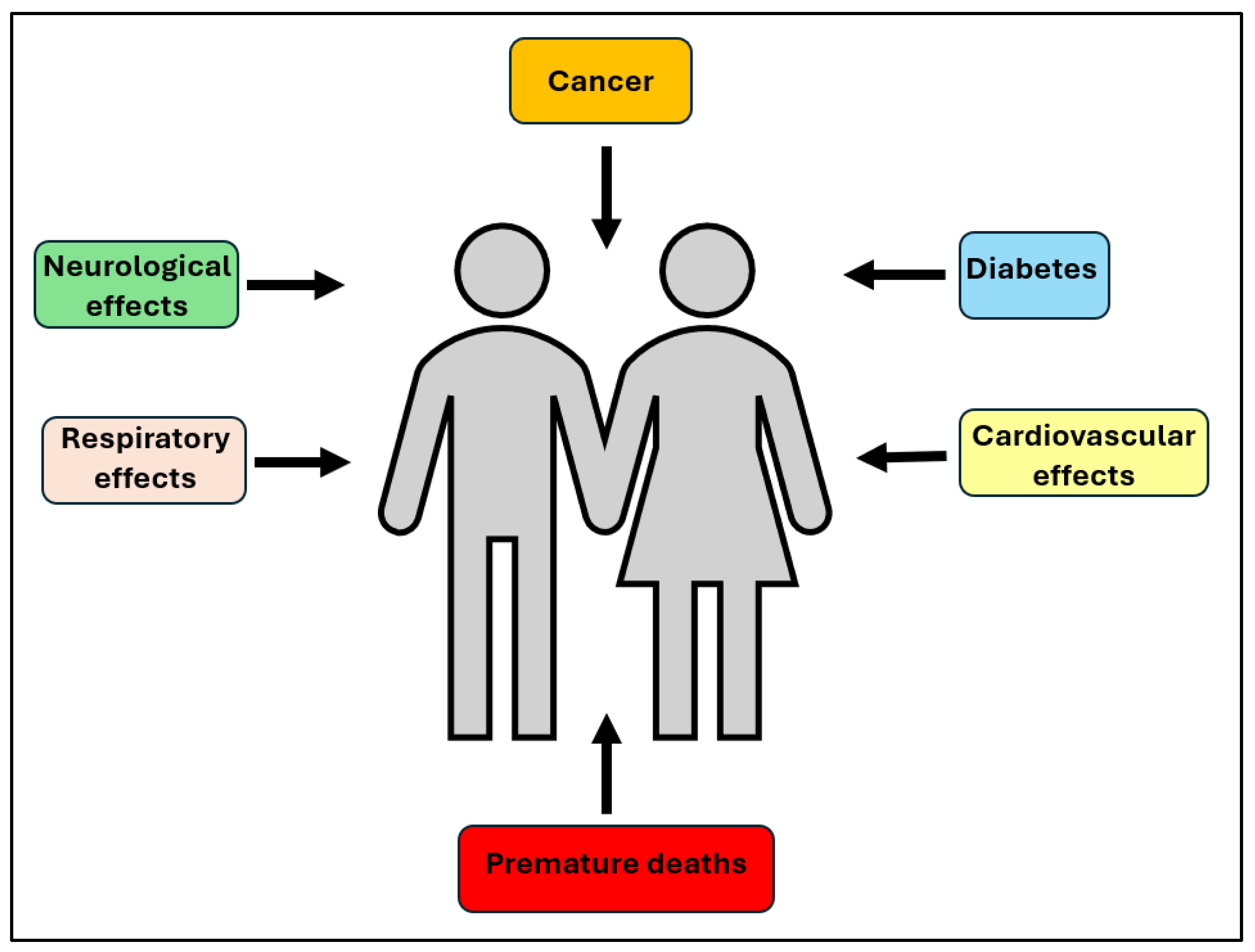
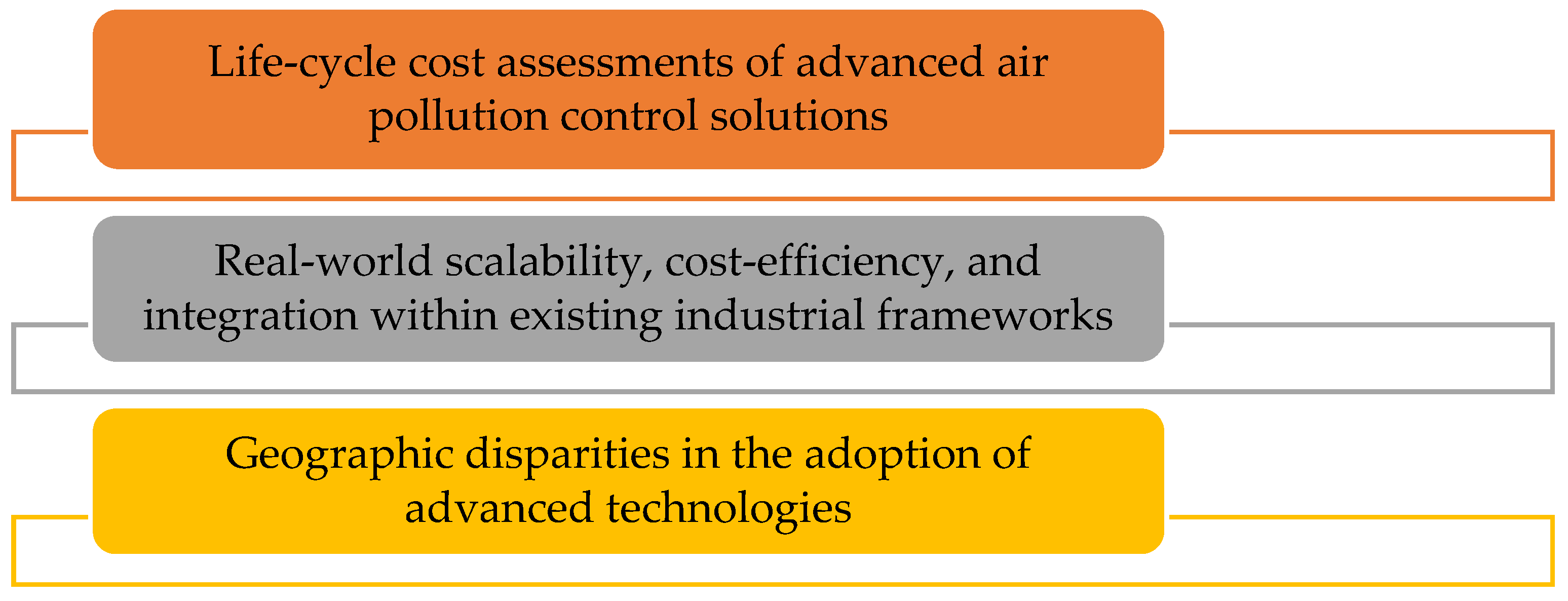
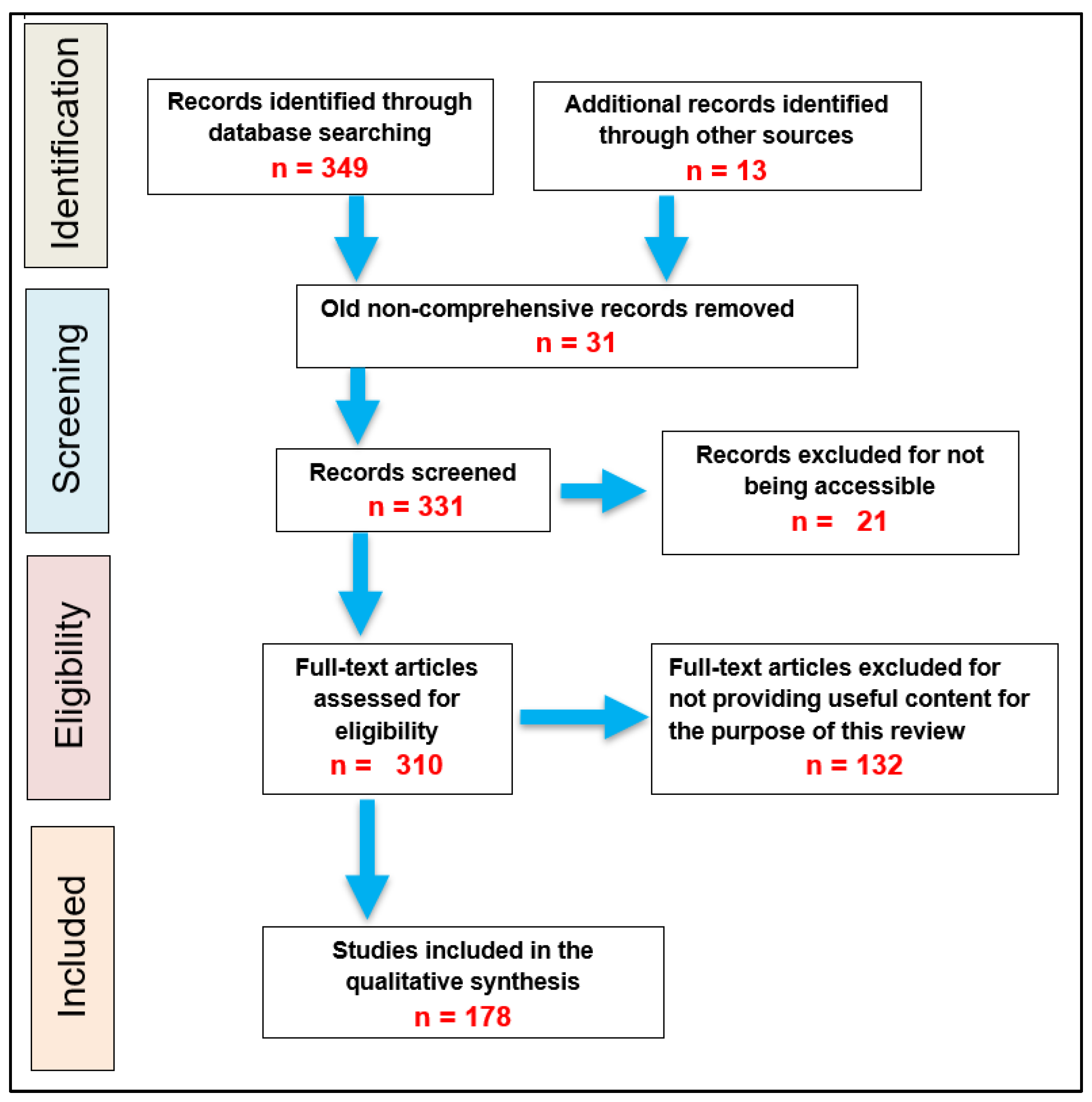

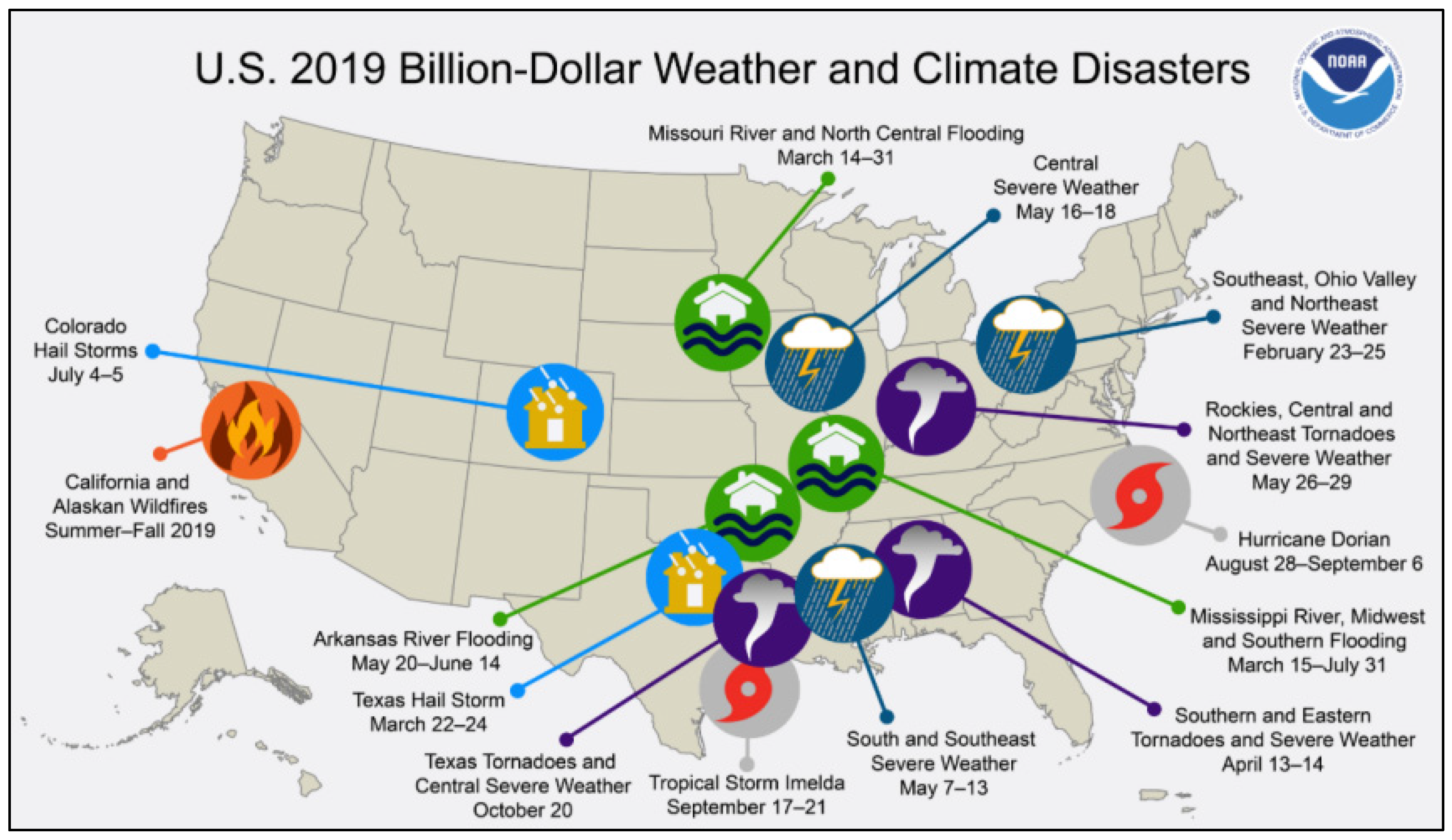
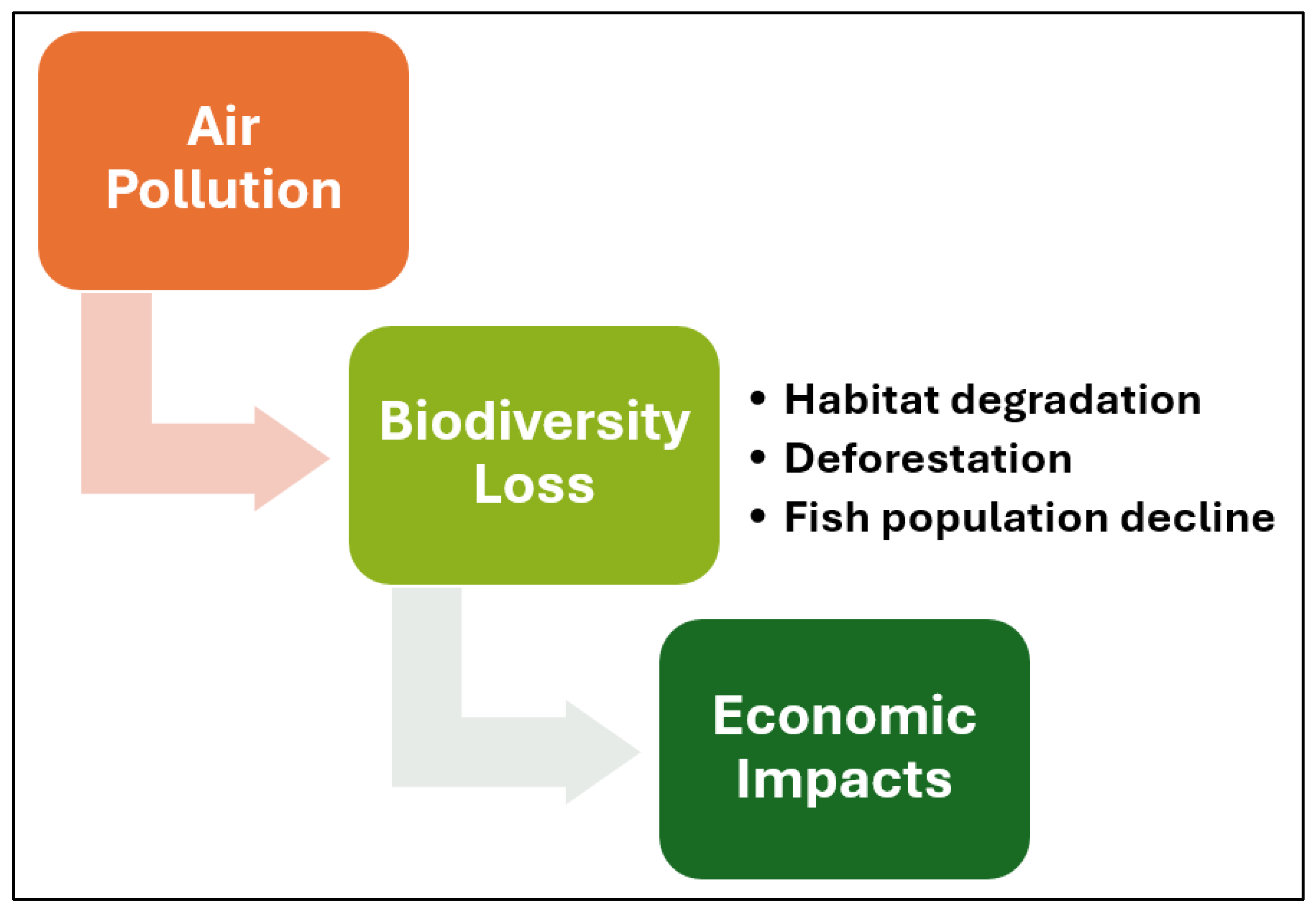
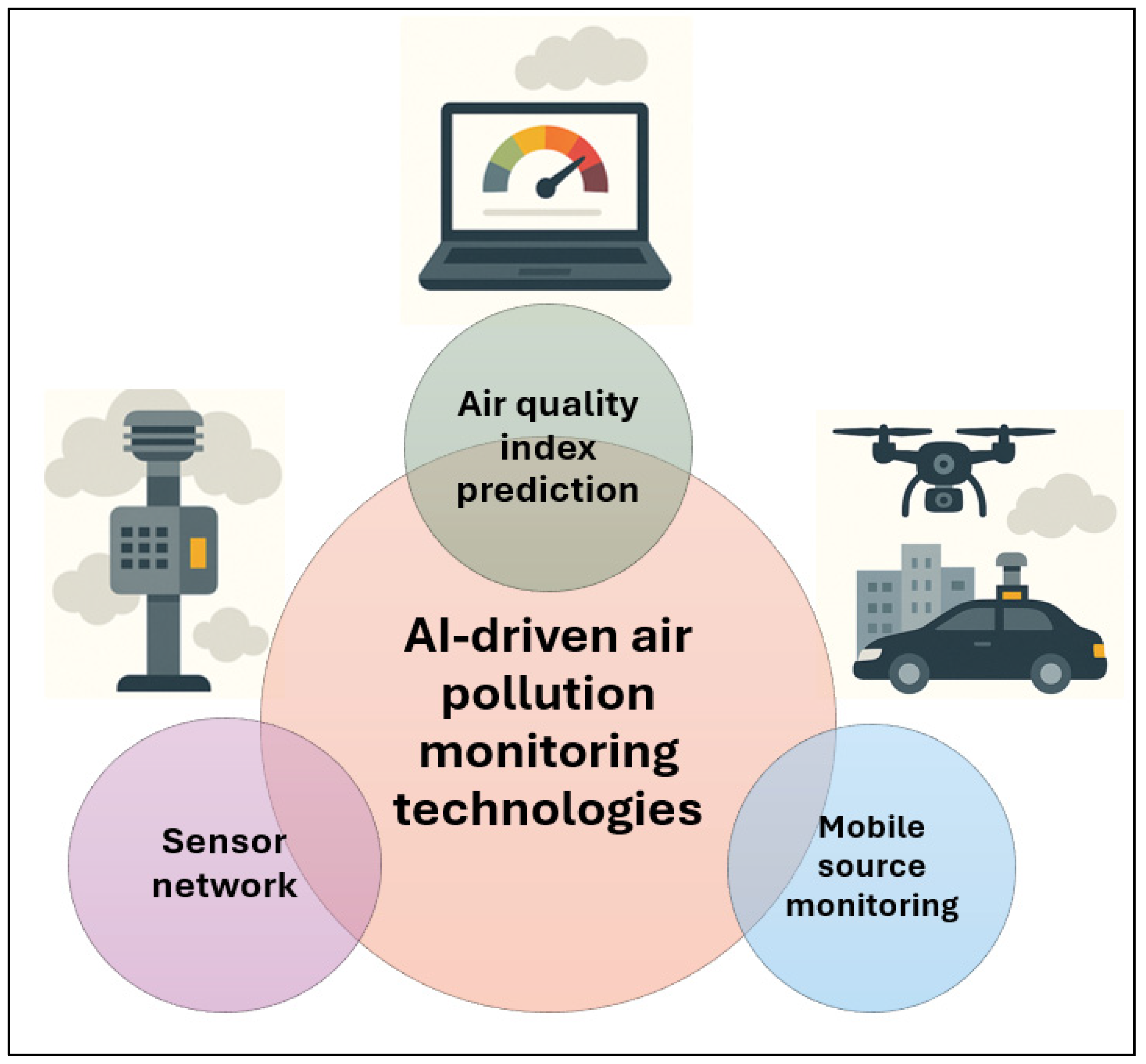
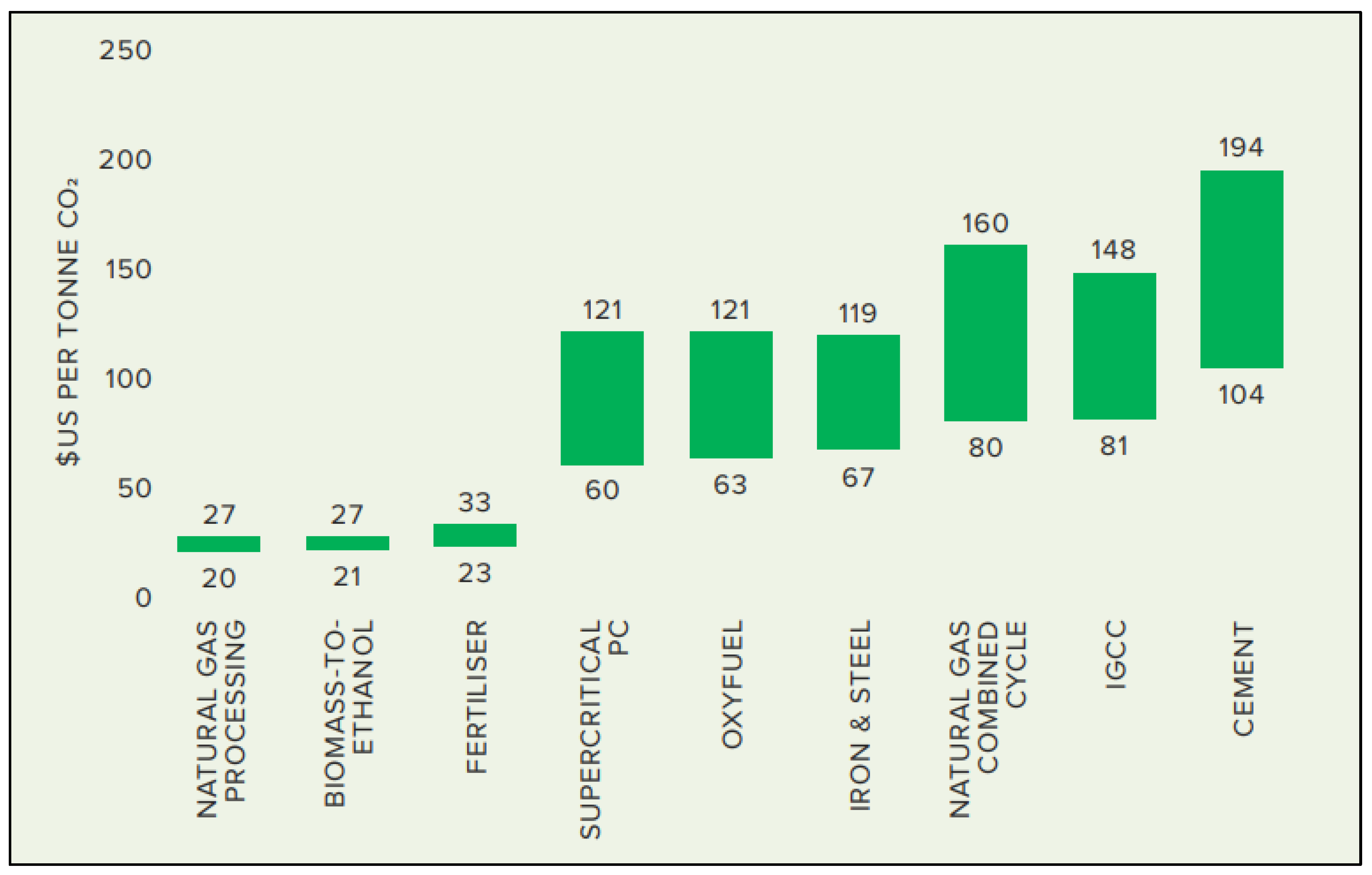
| Aspect | Cost of Illness (COI) Model | Willingness to Pay (WTP) Model |
|---|---|---|
| Definition | Estimates economic costs of diseases caused by air pollution (medical costs, lost productivity). | Measures what individuals are willing to pay to avoid health risks from air pollution. |
| Focus | Direct and indirect costs of illness. | Individual preferences and perceived value of health. |
| Methodology | Based on actual healthcare expenditures and lost workdays. | Uses surveys (contingent valuation) or revealed preferences (e.g., housing prices in cleaner areas). |
| Strengths | -Objective, data-driven. -Useful for policy cost assessments. | -Captures intangible costs (pain, suffering). -Reflects societal preferences. |
| Limitations | -Ignores non-market impacts (e.g., quality of life). -Underestimates true societal cost. | -Subjective and survey-dependent. -May overestimate due to hypothetical bias. |
| Valuation of Mortality | Uses the cost of premature death (lost earnings). | Values statistical life (VSL) based on WTP to reduce mortality risk. |
| Policy Use | Best for short-term healthcare budgeting. | Preferred for long-term welfare analysis. |
| Data Requirements | Relies on health statistics and economic data. | Requires extensive surveys or market behavior data. |
| Example Application | Calculating hospital costs from asthma due to PM2.5. | Estimating WTP for cleaner air to reduce lung cancer risk. |
| Category | Cost ($) |
|---|---|
| Operating labor | 12,960 |
| Supervision and Coordination | 6264 |
| Maintenance (Labor + Materials) | 12,360 |
| Utilities | 56,362 |
| Waste Disposal | 155,676 |
| Total Direct Cost | 243,622 |
| Overhead + Administration | 92,737 |
| Capital Recovery | 216,748 |
| Total Annual Cost | 553,107 |
| Source | Data Point | Source |
|---|---|---|
| OECD (2022) | AI-based air pollution monitoring improved response time by 35% | [95] |
| WHO (2023) | CCS reduces premature mortality from emissions by 12% in pilot cities | [96] |
| IEA Case Study (2023) | Nanofiltration in desalination reduced water-energy costs by 22% | [97] |
| Time | Events | Reported Health Impact |
|---|---|---|
| Starting at week 1 | Ireland’s indoor smoking ban | 13% reduction in all-cause mortality, 26% reduction in ischemic heart disease, 39% reduction in COPD |
| 17 days | Olympic Games | Decrease in clinic visits, emergency department visits, and hospitalizations for childhood asthma |
| Weeks | Steel mill closure | Decrease in respiratory symptoms, school absenteeism, daily mortality, and premature births |
| 4 weeks | Home heater change | Improved asthmatic symptoms |
| 1 month | Irish smoking ban (workers) | Decreased wheezing, dyspnea, cough, phlegm, irritated eyes, sore throat, nasal itch, runny nose, sneezing |
| 2 months | Olympics | Improved lung function; fewer asthma-related visits; decreased cardiovascular mortality |
| 8.5 months | Smelters strike | 2.5% decrease in mortality |
| Pregnancy term | Clean cookstoves | Higher birthweights, increased gestational age, decreased perinatal mortality |
| 6 years | Swiss air pollution decreases | 15.5% decrease in respiratory deaths; 10% decrease in cardiac deaths |
| 7 years | USA PM2.5 reduction tracking | Life expectancy increased by 0.35 years per 10 µg/m3 PM2.5 reduction |
| 10 years | Fine particle reduction (modeling) | Life expectancy gain of 7 months |
| 15 years | Harvard 6 Cities Study | 27% reduction in risk of death due to PM2.5 reductions |
| 25 years | US EPA estimates | Health benefits exceed costs by a factor of 32:1 |
| Aspect | Opportunities | Challenges |
|---|---|---|
| Preventing Carbon Leakage | Discourages companies from relocating to countries with lax environmental regulations by equalizing carbon costs across borders. | Risk of trade disputes and retaliation from countries affected by the adjustments. |
| Promoting fair competition | Level the playing field for domestic industries adhering to stringent carbon regulations against foreign competitors | Complex implementation requires an accurate assessment of carbon content in imported goods. |
| Encouraging global emission reductions | Incentivizes other nations to adopt carbon pricing mechanisms to avoid border adjustments. | Potential negative impact on developing countries’ economies reliant on exports. |
| Generating revenue | Funds collected can be reinvested into domestic climate initiatives and green technologies. | Administrative costs associated with monitoring and enforcing compliance. |
| Driving innovation | Encourages industries to innovate and adopt cleaner technologies to remain competitive. | Diplomatic tensions arise from perceived protectionist measures. |
| Category | Benefit | Estimate/Description |
|---|---|---|
| Revenue Generation | Total revenue from carbon tax | $2.7 trillion over 20 years |
| Deficit Reduction | Contribution to reducing the federal deficit | $815 billion over 20 years |
| Corporate Tax Reform | Lower corporate tax rate using carbon tax revenue | From 35% to 28% |
| Support for Low-Income Households | Revenue set aside to offset tax regressivity | $405 billion over 20 years (15% of revenue) |
| Environmental Impact | Reduction in GHG emissions | 12% reduction over 20 years; 9.2 billion metric tons avoided |
| Climate Benefits | The monetized value of CO2 reductions | $148 billion (based on $16/ton value) |
| Regulatory Efficiency | Reduction in inefficient energy subsidies | $120 billion in savings |
| Area of Impact | Expected Benefit | Quantitative Estimate/Source |
|---|---|---|
| GDP Growth | Boosted by clean air investments, tech innovation, and public health improvements | Up to 3% annual GDP growth (economic modeling) |
| Healthcare | Reduced public and private medical expenditures due to improved air quality | $30–$40 saved per $1 spent on mitigation (World Bank estimate) |
| Worker Productivity | Fewer illness-related absences and better cognitive performance | Linked to improved air quality and lower pollutant exposure |
| Agriculture | Higher yields and better soil quality due to less ozone pollution | 10–15% increase in global agricultural output (research estimate) |
| Real Estate | Increased property values in areas with low pollution | Properties in clean-air zones are worth 20–30% more than in polluted zones |
| Tourism and Urban Investment | Higher tourism and revitalization in cities implementing clean air policies | Examples: London & Paris’ economic activity grew post-low-emission zone implementation |
| Environmental Restoration | Lower long-term ecological repair costs from decreased pollution | Included in $30–$40 return per $1 invested (World Bank estimate) |
Disclaimer/Publisher’s Note: The statements, opinions and data contained in all publications are solely those of the individual author(s) and contributor(s) and not of MDPI and/or the editor(s). MDPI and/or the editor(s) disclaim responsibility for any injury to people or property resulting from any ideas, methods, instructions or products referred to in the content. |
© 2025 by the authors. Licensee MDPI, Basel, Switzerland. This article is an open access article distributed under the terms and conditions of the Creative Commons Attribution (CC BY) license (https://creativecommons.org/licenses/by/4.0/).
Share and Cite
Melhim, S.H.; Isaifan, R.J. The Energy-Economy Nexus of Advanced Air Pollution Control Technologies: Pathways to Sustainable Development. Energies 2025, 18, 2378. https://doi.org/10.3390/en18092378
Melhim SH, Isaifan RJ. The Energy-Economy Nexus of Advanced Air Pollution Control Technologies: Pathways to Sustainable Development. Energies. 2025; 18(9):2378. https://doi.org/10.3390/en18092378
Chicago/Turabian StyleMelhim, Sadiq H., and Rima J. Isaifan. 2025. "The Energy-Economy Nexus of Advanced Air Pollution Control Technologies: Pathways to Sustainable Development" Energies 18, no. 9: 2378. https://doi.org/10.3390/en18092378
APA StyleMelhim, S. H., & Isaifan, R. J. (2025). The Energy-Economy Nexus of Advanced Air Pollution Control Technologies: Pathways to Sustainable Development. Energies, 18(9), 2378. https://doi.org/10.3390/en18092378








